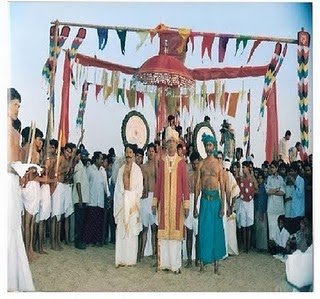
Thirunavaya is the abode of the gods and it impresses one with its breathtaking natural beauty. On the banks of Nila or Bharatapuzha, a 203 km long river, the second longest after Periyar,is a famous holiday location in SouthIndia .Mamankam,Bharathappuzha(Nila), Nilapadu thara,navakumunda temple,lotus cultivation are the main tourist attraction.

According to Brahmin tradition, after the creation of Kerala, Parasurama planted sixty-four joint Brahmin families and gave them law and order to govern themselves. But the Brahmins invited rulers called 'Perumals', from outside to rule them. Each ruler was appointed for a period of 12 years. At the end of the 12th year, a new king was selected following a grant cultural event what came to be known as Mamankam.
Mamankam was held once in every 12 years at Thirunavaya, on the banks of the river Bharathapuzha. Celebrated for 28 days, it was also an enormous trade fair in which traders from various places came to Thirunavaya. At the grand finale, which was a great assembly of rulers, the new king of Kerala was selected. Two of the earlier kings who are known to have abdicated their thrones following this route were Kulasekara Alwar (8th century) and Cheraman Perumal (A.D 825). |
|

 With the rule of the Perumals coming to an end, the right to conduct Mamankam vested with the ruler of Valluvanad. As mentioned earlier, Mamankam was also an enormous trade fair and thus of high economical advantage for its controllers. This triggered bitter strife among the rulers over the right to conduct and control Mamankam. Later the Zamorin of Kozhikode, took this right by force and this resulted in dispute and bloodshed between these two kings. With this incident the basic purpose of Mamankam ( selection of new king ) changed and it became a game of revenge between the two rulers, in which the king of Valluvanad used to send Chavers (suicide warriors) to fight until death and recapture the right from the Zamorins. A Mamankam was held at the end of each 12th year. During this time, the Zamorin would stand waiting at the Nilapadu Thara surrounded by a huge contingent of soldiers and a battle was fought between the chavers and the soldiers of the Zamorin. The last Mamankam to be held at Thirunavaya was in 1755.  
Events like Mamankam were unique to Kerala. Thirunavaya on the banks of Bharathapuzha is now an area of historical importance and the Nilapadu Thara is now under the control and protection of the Archeological Dept. It is also an important tourist spot.
Thirunavaya is located along the banks of Bharatha puzha (also known as Nila),the second largest river of kerala with a length of 209 kilometres.The word "Nila" indicates the culture more than just a river. Nila has groomed the culture and life of south Malabar part of Kerala. We see the name "Peraar" indicating the same river in ancient scripts and documents. |

Thirunavaya is the abode of the gods and it impresses one with its breathtaking natural beauty. On the banks of Nila or Bharatapuzha, a 203 km long river, the second longest after Periyar, we have three glorious temples, dedicated to the Creative, Preservative and Destructive aspects of Time Eternal !
Hindus do srardham or bali ( rites to the departed ) , that is respect those who have gone to the astral plane.
Millions come here because of the natural beauty, the greenish landscape architecture done by Nature and the proximity of the three temples dedicated to Lord Brahma, Lord Shiva and Lord Vishnu.
The famous Nava Mukunda Temple lies on the bank the of the second largest river in Kerala, the Bharatapuzha. It is believed to be 6000 years old. The sanctum sanctorum is adorned by great sculptures which defiy imagination. You can see the mythological Ten Incarnations of Vishnu along with the story of Lord Shiva in his tribal avatar, blessing Arjuna with the Pasupatha Arrow.This temple has a ten day annual festival starting with Kodiyettam and ending in Arattu. Lakhs of people visit this temple during the festival.
The famous Vedic Othanmar Madhom, is on the bank of Bharatapuzha, near the Lord Shiva temple. This institute was a center of Aryanisation thorough Vedic Knowledge and Sanskrit and Thirunavaya is believed to be the main center, where Parasurama,one of the Ten Incarnations of Lord Vishnu, brought and settled Brahmin scholars.
The Chaver of manmakam used to fight till death and their dead bodies are believed to be buried in a well nearby named ‘Manikkinar’ and pressed and covered with help of elephants.Manikkinar can be located now in the premises of CSI Mission Hospital codacal.

A stage where king Zamorin used to sit and control the festival surrounded by his soldiers while the chavers fight with them to kill him.
One of the oldest tile factories in Kerala established by the British.It still contains some symbols of the British Empire .
Thirunvaya is one among very few centres of lotus cultivation centres of kerala.It extends over 10 acres in the VALIYA PARAPPOOR KAYAL.It is supplied to major temples of Kerala including Guruvayoor and Navakumunda temples |
| | |


















No comments:
Post a Comment